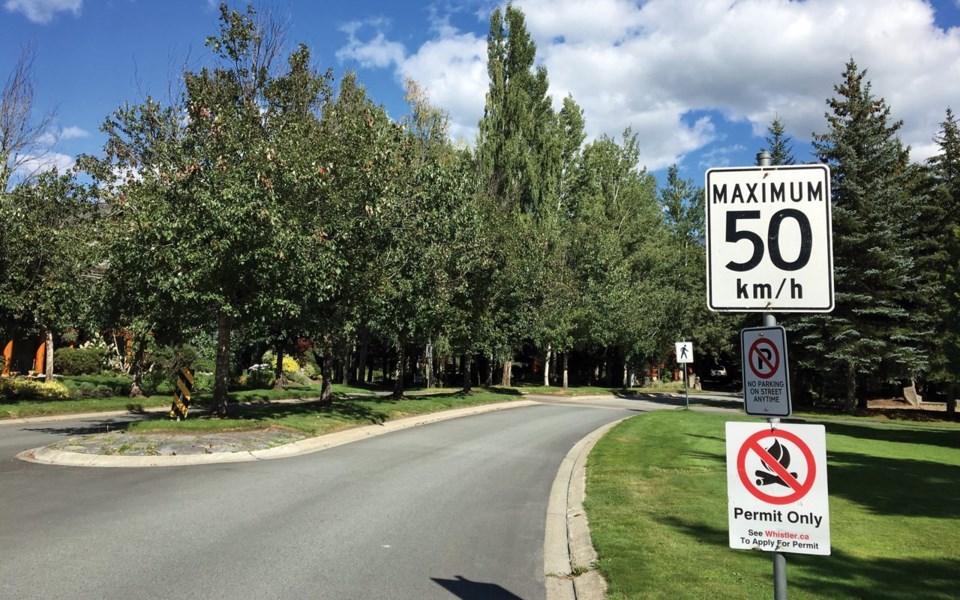Whistler has moved closer to seeing speed limits lowered in its neighbourhoods after council gave first three readings this week to a bylaw amendment.
At the regular meeting of council on Tuesday, Aug. 17, elected officials voiced their support for a move that would reduce limits from 50 kilometres an hour to 30 in the resort’s neighbourhoods, something they first began considering in 2019.
“It's taken a while but I think we got everything right and [did] all the due diligence that was required, and I think it's one of those things that future councils will look back or future residents will look back on and think, ‘Oh, it wasn't always like this?’” said Councillor Ralph Forsyth. “But now, it just seems like such an obvious good thing to do.”
The reduction would come with a number of benefits, including the obvious safety improvements. During the meeting, Andrew Tucker, transportation manager for the Resort Municipality of Whistler (RMOW), presented an eye-opening chart that showed the risk of death and injury to pedestrians stuck by vehicles travelling at different speeds. According to the World Health Organization, pedestrians have an 80-per-cent chance of death when struck by a vehicle travelling 50 km/h, compared to just 10 per cent for vehicles going 30 km/h. The chance of slight injury (as opposed to serious injury or death) increases to 75 per cent at 30 km/h, from two per cent at the higher 50 km/h rate.
It would also help move Whistler further towards its climate goals, Tucker said, with the idea being that drivers would be encouraged to get out of their cars and walk with the added safety in mind.
“[T]hey don't feel safe walking on the roadway that they live on, so this promotes that changing behaviour,” he said. “And it also reduces our greenhouse gas emissions [because] vehicles that we're not driving or vehicles that are going slower reduce our GHG impact as a community.”
The RMOW tested a speed reduction pilot project in Function Junction in both 2019 and 2021 that included a lower limit of 40 km/h, along with additional road lines, flashing crosswalk indicators and several physical barriers. According to a staff report, vehicle monitoring both before and after the measures were implemented “clearly showed a reduction in the average vehicle speeds.”
The change would apply to all municipal roads with direct property access. Not included would be certain private and rural roadways, including a section of Alta Lake Road that Tucker called “less populated [and] more rural” that would continue under the 50 km/h limit, as well as Highway 99, which falls under provincial jurisdiction. (The limit would still be reduced in the residential area of Alta Lake Road adjacent to the south end of Rainbow Park.)
If adopted, the bylaw amendment would also come with the installation of dozens of new signs, which would be rolled out in a phased manner and include “gateway” signs at the entrance to subdivisions, and an awareness campaign led by the RMOW’s communications department, with support from the RCMP.
“It's in part an educational program that we can push forward,” said Jim Dunlop, senior engineering technologist with the RMOW. “The more we can inform people of the change, the less physical signage we hope will have to be out there. And then, as people get used to the change, there should be a greater uptake.”
The lowered limit is just one tool the municipality would utilize to get drivers to slow down, coupled with other traffic-calming measures, such as permanent pylons, graded paving and speed cushions, that have either already been implemented or are still to come.
“That's still part of the program, and we actually just installed some speed cushions on Rainbow Drive and in Alpine very recently to slow the speeds coming through that zone. So it's not like we will not utilize those tools, but we balanced those elements with operational needs [and] snow clearing,” noted Tucker, who added that speed cushions can sometimes hamper snowploughing.
The push to reduce speed limits in Whistler’s neighbourhoods was motivated in part by a letter-writing campaign by residents of Nicklaus North, who pointed to cities such as Montreal, Seattle and Paris that have already instituted reduced limits, as well as Coun. Jen Ford, who attended the 2019 Vision Zero Summit in Surrey, where close to 100 road safety experts, municipal government staff, civic leaders, researchers and public health professionals discussed road safety.
“This is not just a small-town problem. This is happening in big cities, which leads us to greater compliance because people will be used to it when they're in Vancouver, and they're in West Van, and other places that have done this work,” Ford said. “Obviously [traffic-calming measures] don't all work in ski towns, but when we can move these neighbourhoods to lower speeds, everyone will be happier and safer and our kids can walk and play, and I'm very excited about that.”





